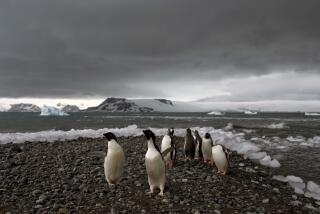Mind Over Matter : SCIENCE FILE: An exploration of issues and trends affecting science, medicine and the environment. : Rising Waters Not a Mere Fantasy
There is a position in which you can hold a globe so that you see nearly an entire hemisphere covered by water. We already live in a water world. So I went to discover what the new movie “Waterworld” could add to this picture.
The movie is based on the simple premise that global warming melts the Earth’s icecaps, causing the oceans to flood the continents, and leaving the remnants of a devastated society to struggle for survival. Sitting in Los Angeles during a summer heat wave, it is hard to avoid wondering: Could global warming actually melt the Earth’s ice deposits, and if so, what would be the consequences?
About two-thirds of the Earth’s surface is ocean.
Perennial ice covers Antarctica, most of Greenland and some high mountainous areas around the globe. (There is also ice floating in the polar seas, but its melting would not affect sea level). The Antarctic ice sheet covers an area larger than that of the United States, and is an average of 2 1/2 kilometers thick. (For reference, the parking lot at Disneyland is about three-quarters of a kilometer across.) The Greenland ice sheet is smaller, about the size of Alaska, and is 1 1/2 kilometers thick. Taken together, these reservoirs hold more than 97% of the Earth’s frozen assets.
If all this ice were to melt, sea level would rise about 80 meters (about 260 feet). And if global warming were to raise the temperature of the upper layer of ocean water as well, the water itself would expand, contributing an additional few inches for every degree centigrade increase in temperature. This would not completely inundate the continents, but it would flood islands and coastal regions around the globe, including much of Europe, and the East Coast of the United States from Florida to Cape Cod.
The effects would extend beyond these regions, with water damage from storm surges and hurricanes reaching much farther inland. The rise in sea level would also pollute ground water used for domestic consumption with brine flowing in from the sea. In the Los Angeles area, the beach communities would of course be affected, and low-lying communities along arroyos could be flooded.
These phenomena are not new. At the peak of the last Ice Age, about 15,000 years ago, the global average temperature was about 8 degrees centigrade (14 degrees Fahrenheit) colder. So much water was locked up in ice that sea level was about 120 meters (almost 400 feet) lower than it is today. Since then, the ice has been melting. Over the past century, sea level has been rising at an estimated rate of about six inches every 100 years.
The current rate of sea level rise is so slow that it is difficult to measure precisely. However, there may be more dramatic changes in the future. For example, the Ross Ice Shelf in West Antarctica is a slab of ice that sits largely over ocean water. As the water circulates, it carries heat that can melt this ice more rapidly than the glaciers sitting over land. If the Ross Ice Shelf were to break up and flow into the sea, the water level would rise globally by about six meters (20 feet). In the worst case, this could happen over a period of as little as a few years.
Even if the catastrophic destruction of an ice shelf does not occur, state-of-the-art climate models suggest that the gases introduced into the atmosphere by burning fossil fuels will raise the global average temperature. This warming could amount to a few degrees over the next hundred years, leading to an estimated tripling in the current rate of sea level rise.
But there are subtleties here. For example, the increase in global temperature could initially allow the atmosphere to carry more water to the polar regions. This would increase the annual snowfall, mitigating the increased melting of existing ice. The sizes of these competing effects is a matter of current research.
There are also larger questions about what will happen to global temperatures. Without human intervention, natural processes such as the wobbling of the Earth’s orbit trigger periodic Ice Ages. According to the geologic record, we have been living through an extended warm period, and are due for a colder one.
Whether “warming” or “cooling” will win out, when, and by how much is not known. We do know that even a slightly drier summer, or a colder winter, can cause great hardships. But much needs to be learned before we will be able to predict how human activity is affecting the climate of Earth.
Until then, there will always be a place for sitting back, suspending disbelief and enjoying the movies.
* Ralph A. Kahn is a research scientist at the Jet Propulsion Laboratory in Pasadena.






